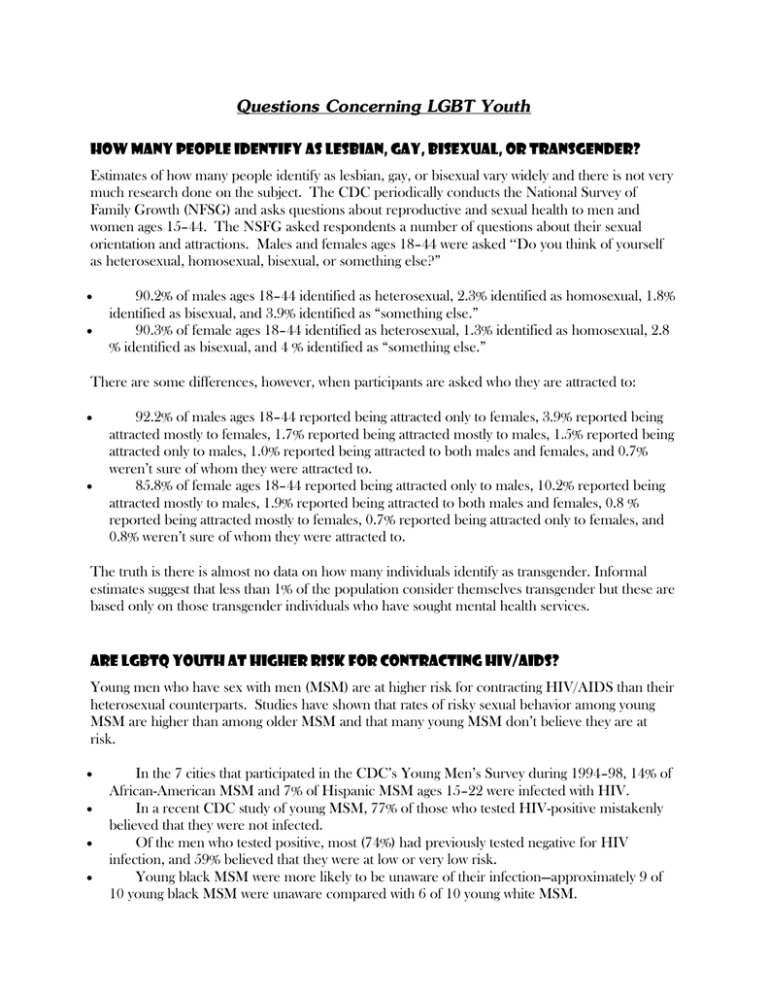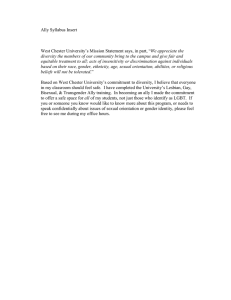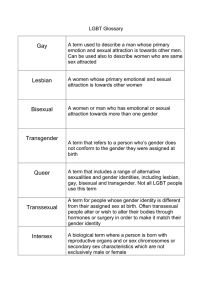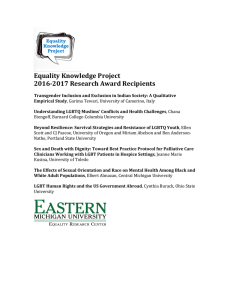
Questions Concerning LGBT Youth
How many people identify as lesbian, gay, bisexual, or transgender?
Estimates of how many people identify as lesbian, gay, or bisexual vary widely and there is not very
much research done on the subject. The CDC periodically conducts the National Survey of
Family Growth (NFSG) and asks questions about reproductive and sexual health to men and
women ages 15–44. The NSFG asked respondents a number of questions about their sexual
orientation and attractions. Males and females ages 18–44 were asked ‘‘Do you think of yourself
as heterosexual, homosexual, bisexual, or something else?”
90.2% of males ages 18–44 identified as heterosexual, 2.3% identified as homosexual, 1.8%
identified as bisexual, and 3.9% identified as “something else.”
90.3% of female ages 18–44 identified as heterosexual, 1.3% identified as homosexual, 2.8
% identified as bisexual, and 4 % identified as “something else.”
There are some differences, however, when participants are asked who they are attracted to:
92.2% of males ages 18–44 reported being attracted only to females, 3.9% reported being
attracted mostly to females, 1.7% reported being attracted mostly to males, 1.5% reported being
attracted only to males, 1.0% reported being attracted to both males and females, and 0.7%
weren’t sure of whom they were attracted to.
85.8% of female ages 18–44 reported being attracted only to males, 10.2% reported being
attracted mostly to males, 1.9% reported being attracted to both males and females, 0.8 %
reported being attracted mostly to females, 0.7% reported being attracted only to females, and
0.8% weren’t sure of whom they were attracted to.
The truth is there is almost no data on how many individuals identify as transgender. Informal
estimates suggest that less than 1% of the population consider themselves transgender but these are
based only on those transgender individuals who have sought mental health services.
Are LGBTQ youth at higher risk for contracting HIV/AIDS?
Young men who have sex with men (MSM) are at higher risk for contracting HIV/AIDS than their
heterosexual counterparts. Studies have shown that rates of risky sexual behavior among young
MSM are higher than among older MSM and that many young MSM don’t believe they are at
risk.
In the 7 cities that participated in the CDC’s Young Men’s Survey during 1994–98, 14% of
African-American MSM and 7% of Hispanic MSM ages 15–22 were infected with HIV.
In a recent CDC study of young MSM, 77% of those who tested HIV-positive mistakenly
believed that they were not infected.
Of the men who tested positive, most (74%) had previously tested negative for HIV
infection, and 59% believed that they were at low or very low risk.
Young black MSM were more likely to be unaware of their infection—approximately 9 of
10 young black MSM were unaware compared with 6 of 10 young white MSM.
It is important to note that the CDC counts M to F transgender women as MSM, and that very
little research exists on the specific health risks transgender individuals face. A number of studies
in different U.S. cities have found HIV prevalence in transgender women ranging from 14–47%
and even higher rates in transgender sex workers.
Are LGBTQ youth at higher risk of contracting other STDs?
There is very little data on STDs other than HIV that is reported by either sexual orientation or
sexual behavior. Some data suggests that men who have sex with men are disproportionately
affected by some STDs. For example, the CDC says that, MSM have accounted for an increasing
number of estimated syphilis cases in the United States. Specifically, in 2006 64% of primary and
secondary syphilis cases were among MSM.
Are LGBTQ youth disproportionately affected by mental health issues?
Discrimination and violence put LGBTQ youth in particularly vulnerable positions with respect to
mental health and suicide. The most commonly cited research on LGBTQ youth and suicide is a
1989 report from the Secretary’s Task Force on Youth Suicide at the United States Department of
Health and Human Services which found that lesbian, gay, and bisexual youth were two to three
times more likely to attempt suicide than their heterosexual peers.
Newer research shows that LGBT youth are still slightly more likely to report a suicide attempt
than heterosexual youth, however, closer analysis revealed that half of the attempts by LGBT
youth were suicidal ideation rather than a concrete act to end life. The researcher believes these
reported attempts are a way that LGBT youth communicate the hardships of their lives.
More recent research published in the American Psychologist also concludes that high rates of
“major depression, generalized anxiety disorder and substance use or dependence” persist in
lesbian and gay youth.
Are LGBTQ youth disproportionately affected by homelessness?
A 2006 report by the National Gay and Lesbian Taskforce and the National Coalition for the
Homeless estimates that between 20–40% of all homeless youth in the United States identify as
LGBT. Given that only 3–5% of Americans identify as lesbian, gay, or bisexual, it’s clear that
homelessness disproportionately affects LGBTQ youth. These numbers are corroborated by a
2005 study funded by the New York City Council which found that almost one-third of New
York’s homeless youth identify as lesbian, gay, bisexual, or transgender.
The primary cause of homelessness for all youth is family conflict, and research suggests that
family conflict over a young person’s sexual orientation or gender identity can often lead to
homelessness.
Is there an increase of public acceptance of LGBTQ individuals?
There is certainly more discussion of sexual orientation in today’s popular culture and media than
ever before, and surveys suggest that there is a corresponding greater acceptance of homosexuality
among the public. A Gallup poll conducted in May of each year asks Americans about their
attitudes related to homosexuality. In 2007, 57% of all Americans said they found homosexuality
to be an acceptable lifestyle compared with 50% in 1998 and just 34% in 1982.
The survey also shows that acceptance of LGBTQ individuals is even higher among younger
generations; 75% of Americans ages 18–34 found homosexuality acceptable.
Do schools teach about sexual orientation?
The content of health and sexuality education varies depending on the community and research
on what topics each community teaches is quite limited.
A recent study of health education programs conducted by the CDC’s Division of Adolescent and
School Health, however, provides some insight into what is being taught in America’s classroom.
The study found that 48% of schools taught about sexual identity and sexual orientation.
Every two years the Gay, Lesbian, and Straight Education Network (GLSEN) surveys LGBT high
school students across the country on their experiences. The 2005 National School Climate
Survey asked students some questions about sexuality education curricula and found that “nearly
half (44.6%) of the students surveyed reported that their school followed an abstinence-only health
curriculum, and these students were more likely to have experienced verbal harassment on the
basis of sexual orientation, and were more likely to have missed school in the past year because
they felt unsafe.” These students also reported having fewer supportive faculty/school staff at their
school.
Are schools safe places for LGBTQ youth?
GLSEN’s 2005 National School Climate Survey concluded that in certain schools and certain
states with supportive laws, the experiences of LGBT youth in schools are improving, but overall
there has been a lack of consistent progress. Most students still hear homophobic remarks and
report feeling unsafe at some point, and many are still victims of physical harassment and assault.
In particular the survey found:
75.4% of LGBT high school students reported hearing remarks such as “faggot” or “dyke”
frequently or often at school.
89.2% of LGBT high school students reported hearing “that’s so gay” or “you’re so gay”
(often used to indicate that someone or something is stupid or worthless) frequently or often at
school.
18.6% of LGBT high school students reported hearing homophobic remarks from their
teachers or other school staff.
74.2% of LGBT high school students in the survey reported feeling unsafe in school
because of personal characteristics, such as their sexual orientation, gender or religion, 64.3%
reported feeling unsafe at school because of their sexual orientation specifically, and 40.7% felt
unsafe because of how they expressed their gender.
64.1% of LGBT high school students reported that they had been verbally harassed at least
some of the time in school in the past year because of their sexual orientation and 45.5%
because of their gender expression.
37.8% of LGBT high school students had experienced physical harassment at school on
the basis of sexual orientation and 26.1% on the basis of their gender expression.
17.6% of LGBT high school students had been physically assaulted because of their sexual
orientation and 11.8% because of their gender expression.
The good news is, there are a growing number of resources and support for LGBTQ youth. The
first Gay-Straight Alliance (GSA)—school clubs that promote tolerance and respect for everyone
regardless of sexual orientation or gender identity—formed in 1988. GLSEN, the Gay, Lesbian,
and Straight Education Network, reports that there are now over 3,000 of the student clubs
registered with their organization.
Are LGBT people coming out at younger ages?
There is not a lot of research on when or why young people choose to publicly identify as gay,
lesbian, or bisexual. Research by Cornell University professor Ritch Savin-Williams, however,
suggests that the average LGBT youth now comes out at 16 compared to 21 in the 1970s.
** Adapted from:
http://www.siecus.org/index.cfm?fuseaction=page.viewpage&pageid=605&grandparentID=477&parentID=591
Questions LGBT Youth and Young Adults Need to
Consider Before Coming Out to Parents
Are you sure about your sexual orientation?
Don't raise the issue unless you're able to respond with confidence to the question "Are you sure?"
Confusion on your part will increase your parents' confusion and decrease their confidence in your
conclusions.
Are you comfortable with your gay identity?
If you're wrestling with guilt and periods of depression, you'll be better off waiting to tell your
parents. Coming out to them may require tremendous energy on your part; it will require a reserve
of positive self-image.
Do you have support?
In the event that your parents' reaction devastates you, there should be someone or a group that
you can confidently turn to for emotional support and strength. Maintaining your sense of selfworth is critical.
Are you knowledgeable about homosexuality?
Your parents will probably respond based on a lifetime of information from a homophobic
society. If you've done some serious reading on the subject, you'll be able to assist them by sharing
reliable information and research.
What's the emotional climate at home?
If you have the choice of when to tell, consider the timing. Choose a time when they're not dealing
with such matters as the death of a close friend, pending surgery, or the loss of a job.
Can you be patient?
Your parents will require time to deal with this information if they haven't considered it prior to
your sharing. The process may last from six months to two years.
What's your motive for coming out now?
Hopefully, it is because you love them and are uncomfortable with the distance you feel. Never
come out in anger or during an argument, using your sexuality as a weapon.
Do you have available resources?
Homosexuality is a subject most heterosexual people know little about. Have available at least one
of the following: a book addressed to parents, a contact for the local or national Parents and
Friends of Lesbian and Gays (PFLAG), or the name of a heterosexual counselor who can deal
fairly with the issue.
Are you financially dependent on your parents?
If you suspect they are capable of withdrawing college finances or forcing you out of the house, you
may choose to wait until they do not have this weapon to hold over you.
What is your general relationship with your parents?
If you've gotten along well and have always known their love and shared your love for them in
return, chances are they'll be able to deal with the issue in a positive way.
What is their moral/societal view?
If they tend to see social issues in clear terms of good/bad or holy/sinful, you may anticipate that
they will have serious problems dealing with your sexuality. If, however, they've evidenced a degree
of flexibility when dealing with other changing societal matters, you may be able to anticipate a
willingness to work this through with you.
Is this your decision?
Not everyone should come out to her/his parents. Don't be pressured into it if you're not sure
you'll be better off by doing so, no matter what their response.
-- Texas A&M University, Gay and Lesbian Student Services Speaker's Bureau Manual




